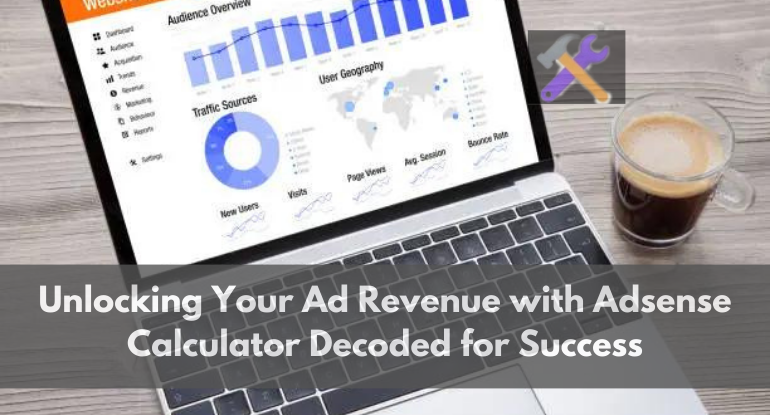
Unlocking Your Ad Revenue with Adsense Calculator Decoded for Success
If you're seeking to enhance your ad revenue using Google AdSense, it's imperative to grasp the inner workings of the AdSense calculator and learn how to harness its potential effectively.
Google AdSense stands as a prominent platform for website and blog monetization, enabling site owners to generate revenue by showcasing tailored advertisements to their audience.
However, the extent of this revenue can be substantially influenced by your strategic approach and a comprehensive understanding of the metrics integral to the AdSense calculator.
In this guide, we'll delve into the essential components that constitute the AdSense calculator and elucidate how to employ it strategically to amplify your earnings.
What is Google Adsense

Google AdSense is an online advertising program developed by Google that allows website owners, bloggers, and content creators to monetize their online content by displaying various types of advertisements.
These ads can be in the form of text, images, videos, or interactive media and are typically relevant to the content of the webpage where they are displayed.
Website owners and publishers can enroll in the Google AdSense program for free. Once approved, they can integrate the provided code into their websites, allowing Google to display targeted ads to their visitors.
Advertisers pay Google to promote their products or services through these ads, and website owners receive a share of that revenue whenever visitors interact with the ads, either by clicking on them (pay-per-click) or simply viewing them (pay-per-impression).
AdSense uses a contextual targeting system to determine which ads to display on a particular webpage. It analyzes the content of the page, the user's location, browsing history, and other factors to ensure that the ads shown are relevant and likely to resonate with the audience.
The program is popular among website owners and publishers because it offers a straightforward way to generate revenue from their online content. It's often used by individuals, businesses, and organizations as an additional income stream to support their websites and online activities.
AdSense provides a platform for advertisers to reach a broader audience, while publishers can earn revenue without having to negotiate individual advertising deals.
Overall, Google AdSense serves as a win-win platform, benefiting both advertisers and content creators in the vast landscape of online advertising.
Understanding AdSense Metrics
Google AdSense provides a variety of metrics that are essential for assessing the performance and revenue potential of advertisements displayed on your website.
These metrics offer valuable insights into how your ads are performing and can help you optimize your ad strategy to maximize earnings. Here's an in-depth expansion on the key AdSense metrics:
#1. Cost Per Click (CPC): Cost Per Click (CPC) is a fundamental metric in the AdSense program. It represents the amount you earn each time a user clicks on an ad displayed on your website.
CPC can vary significantly based on the specific ad, its content, the niche of your website, and the competitive landscape in the advertising market. Certain niches command higher CPC rates due to increased advertiser demand or the nature of the products or services being promoted.
Understanding the CPC associated with different ads is crucial for optimizing your revenue. Publishers often strive to attract ads with higher CPC rates to increase their earnings for every click generated by their audience.

#2. Click-Through Rate (CTR): Click-Through Rate (CTR) is a pivotal metric that indicates the percentage of ad clicks in relation to the number of ad impressions.
It is calculated by dividing the total clicks on ads by the total number of ad impressions, then multiplying by 100 to express it as a percentage.
A higher CTR generally signifies that a substantial proportion of your audience finds the displayed ads relevant and engaging. Advertisers view a high CTR as a positive indicator of ad effectiveness, and it can result in higher revenues for publishers.
An effective ad strategy aims to optimize CTR through strategic ad placements, engaging ad content, and targeting the right audience.
#3. Page RPM (Revenue per Mille): Page RPM, or Revenue per Mille, is a crucial metric that calculates the estimated earnings you generate per 1,000 ad impressions.
The formula for calculating Page RPM is simple: it is obtained by dividing the total earnings from ads by the number of page views (in thousands). Essentially, it gives you an idea of how much revenue you can expect to earn for every 1,000 impressions on your site.
Monitoring your Page RPM helps in evaluating the overall effectiveness of your ad placements and the relevance of ads to your audience. A higher Page RPM indicates efficient monetization strategies and can guide you in optimizing your content and ad formats to increase revenue.
#4. Impressions: Impressions refer to the number of times ads are fetched and displayed on your website. Each time an ad is loaded and viewed by a user, it counts as one impression. Increasing the number of impressions can potentially lead to more ad clicks and subsequently higher earnings.
Publishers often aim to boost impressions by optimizing website traffic and ensuring that their website's content attracts a substantial audience. More impressions provide a greater opportunity for users to interact with the ads, ultimately influencing revenue positively.
#5. Earnings: Earnings encompass the total amount you've generated from displaying ads on your website. This includes the revenue from both pay-per-click (CPC) and pay-per-impression (PPM) models.
It represents the financial value you've accrued from the ads being viewed and clicked by your audience.
Monitoring your earnings is vital for assessing the effectiveness of your overall ad strategy and understanding how changes in CPC, CTR, and impressions impact your revenue.
It guides you in making informed decisions to optimize your monetization approach and improve your website's ad performance.
AdSense Calculator
The AdSense calculator helps estimate potential earnings based on your site's traffic and ad performance. Here's a simple formula to calculate earnings:
Earnings=Impressions×CTR×CPC
The Role of Adsense Calculator
The AdSense calculator plays a crucial role in helping website owners and publishers optimize their ad revenue and understand their potential earnings through the Google AdSense program.
It's a tool that aids in estimating and strategizing the income generated from displaying advertisements on a website or blog.
Here's how the AdSense calculator functions and the role it plays:
#1. Revenue Estimation: The AdSense calculator helps in estimating potential revenue based on various factors like ad impressions, click-through rate (CTR), cost per click (CPC), and overall traffic to the website.
It allows publishers to project their earnings and make informed decisions regarding their ad placements and strategies.
#2. Performance Analysis: Publishers can analyze the past performance of their ads using the AdSense calculator. By inputting historical data or hypothetical figures, they can assess how changes in metrics such as CTR, CPC, or traffic can impact their revenue.
This analysis guides them in adjusting their content or ad placement strategies for better results.
#3. Optimization Planning: The calculator enables publishers to experiment with different scenarios to optimize their ad revenue. They can explore the impact of increasing CTR, improving ad placement, or enhancing website traffic on their earnings. This helps in developing strategies to maximize revenue potential.
#4. Customization and Insights: Publishers can customize inputs in the AdSense calculator based on their specific circumstances. This customization provides tailored insights into how tweaks in various parameters can influence ad revenue.
It's a tool to fine-tune strategies based on the unique characteristics of their website and audience.
#5. Educational Tool: The AdSense calculator serves as an educational tool, especially for newcomers to the AdSense program. It helps in understanding how different elements such as ad impressions, CTR, CPC, and traffic interplay and contribute to overall revenue. It educates publishers on the financial dynamics of online advertising.
#6. Goal Setting: Publishers can set revenue goals using the AdSense calculator. By inputting target earnings and adjusting other variables, they can determine what level of performance is needed to meet their financial objectives. It aids in setting achievable benchmarks and tracking progress.
Tips to Boost Ad Revenue

Monetizing your website effectively with Google AdSense requires strategic planning and continuous optimization to maximize ad revenue. Here are actionable tips to enhance your earnings through this advertising platform:
#1. Optimize Ad Placement: Strategic ad placement is critical for maximizing ad revenue. Position ads where they are easily visible and relevant to your content.
Experiment with different ad formats and positions to determine what resonates best with your audience. Tailoring the ad placement to seamlessly integrate with your content can enhance user engagement and boost click-through rates.
#2. Improve Content Quality: Compelling and valuable content is a magnet for attracting more visitors to your website. Engaged visitors are more likely to interact with the displayed ads, leading to higher ad engagement rates.
Focus on creating high-quality, relevant, and informative content that aligns with your target audience's interests. Quality content not only attracts more traffic but also encourages repeat visits, ultimately increasing ad revenue potential.
#3. Keyword Optimization: Utilize relevant keywords strategically within your content. This practice not only improves your website's visibility in search engine results but also attracts ads with higher Cost Per Click (CPC).
Advertisers often bid more for ads related to specific keywords, and incorporating these keywords can help optimize your ad earnings by attracting higher-paying ads to your website.
#4. Mobile Optimization: As the number of mobile users continues to rise, it's crucial to ensure that your website is mobile-friendly and provides a seamless user experience on various mobile devices.
Mobile optimization is not only essential for user satisfaction but also for maximizing ad revenue. Ad formats that are optimized for mobile devices can significantly improve ad performance and revenue from mobile traffic.
#5. Monitor Performance Regularly: Utilize AdSense reports and analytics to track your performance consistently. Regular monitoring helps you identify trends, understand user behavior, and pinpoint which strategies are working best for your website.
Analyzing these insights empowers you to make informed decisions to optimize your ad placements, content strategy, and overall user experience to boost revenue.
#6. Experiment and A/B Test: Continuously experiment and conduct A/B tests to optimize your ad strategy. Test different ad placements, ad sizes, colors, and even ad types to determine what resonates most effectively with your audience.
A/B testing allows you to gather data on user preferences and behaviors, enabling you to make data-driven decisions that can significantly impact your ad revenue.
Conclusion
Unlocking your AdSense revenue potential requires continuous effort and experimentation. By understanding the AdSense calculator and implementing strategic optimizations, you can increase your ad revenue and make the most out of your website's traffic.